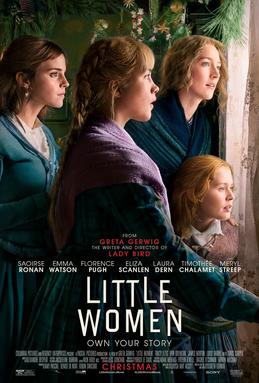‘Little Women’: A coming-of-age classic

The film stunned both critics and viewers when it premiered in theaters on Dec. 25.
January 16, 2020
“Little Women,” a novel that has maintained relevance for 150 years, is difficult to skillfully adapt into film, as illustrated by past attempts at adaptations. However, the director, Greta Gerwig, executed the challenge with both beauty and genius. In the words of the author of “Little Women,” Louisa May Alcott, “I’m not afraid of storms, for I’m learning how to sail my ship.”
The film stunned both critics and viewers when it premiered in theaters on Dec. 25. It recently received six Academy Award nominations, including Best Picture. The movie contains a multitude of themes, including the pains of growing up, the economics of marriage, female autonomy and familial dynamics.
The film begins with the main character, Jo, played by Saorise Ronan, attempting to sell her stories. Set during the Civil War era, it follows the lives of the four March sisters from childhood to adulthood. This adaption diverts from other remakes by creating parallels between Jo and Louisa May Alcott, and the subtle perspective of the author creates shots focused on details rather than scenery. This diversion affects the film in every way, creating a thoughtful and deliberate story line rather than a bland one. A writer’s view recognizes the small things, so the perspective of Jo intertwined with Lousia May Alcott leads to a magnificent product. The costume design, for example, features a signature color in every costume for each sister, with the mother’s costumes containing all the colors of her daughters. It is the minutiae such as this that separates the wheat from the chaff in the modern mass production of films. The high element of detail creates such depth that every idiosyncrasy cannot be caught during the first viewing, which is a common indicator of quality film.
The camerawork holds a deliberate feeling, and the quality of acting by Saorise Ronan, Florence Pugh, Timothee Chalamet and others is incredible. I ended up watching the movie three times in theaters, and I have to admit that I cried profusely all three times. The constant movement in the film is laudable, as the immaculate blocking creates an immersive relationship between the viewer and the screen. Extensive blocking is an underrated tool in film to express relational dynamics, and Gerwig utilizes blocking exceptionally. The cinematography in this film differs from Gerwig’s critically acclaimed “Lady Bird,” as it expresses emotions and plotlines through images more than dialogue, thus causing the dialogue to hold more profundity while also creating a tone of realism. It depicts the simplicity of day to day existence and the struggles of domestic life with care.
The plot is shown through a nonlinear storyline, inventing humanity for every character by demonstrating the effects of time and hardship. In past adaptations, two of the sisters, Amy and Meg, have been antagonized for their perceived selfish behavior. Unlike other members of the March Family, Meg and Amy seek material wealth and social acceptance. The nonlinear storyline illustrates the growth that both characters, especially Amy, experience. They are thoroughly redeemed through their character arcs, causing the viewer to reflect upon the accuracy of quick judgment. The intrigue of the different personalities portrayed creates a resonating emotional aspect; there’s a part of every character that connects with the viewer.
The film also deals with ideas regarding feminism, female autonomy, and the economic proposition of marriage. It is to be noted, however, that it doesn’t touch on the far more severe issues that black women faced, but specifically looks at the struggles of a white woman during that era. The film contrasts the 1994 adaptation in its expression of female agency and open discussion of the oppression of women. In fact, the director of the 1994 version purposefully avoided a feminist tone, while Gerwig welcoms it with capable arms. Gerwig herself has dealt with the obstacles of misogyny. She has had to work twice as hard to get half the credit as a woman in film, a predominantly male career. It is also interesting to note that this year’s Academy Awards nominations for director only include men, meaning that Gerwig’s name did not appear, even though I think that she was very much deserving.
The theme of maturity is expressed as the film progresses, demonstrating the universal experience of movement from innocence to acceptance, or from ignorance to knowledge. The pain of growing up deals with an initial desire for independence followed by a reluctance to be on one’s own. During childhood scenes, Gerwig uses a warm filter to symbolize the happiness and security of youth. The golden tones illustrate the childhood idea of endless possibilities. Cool tones are used during adulthood, representing the cold loneliness and isolation that accompanies adulthood. The movement also slows down during adulthood, perhaps symbolizing a loss of hope. The immersive transition of color struck me hard. I realized that nostalgia is romanticized because of the youth surrounding it, not because of the memory itself. As children, we believe that summer will never end, and that loved ones never die. The world feels full and our hearts brim with expectations. Yet winter is imminent and death unavoidable, as shown by the death of one of the March sisters. Our lives take roads that pain us, and hope is often crushed. However, the harsh reality of failed dreams and lost loved ones is still shown in a way of beauty, emphasizing the theme that beauty is found even in pain.
I highly recommend this movie to anyone, and I hope that they appreciate it as much as I do. An aesthetically pleasing film, the “Little Women” screenplay and overall direction lead me to believe that it will go down as a classic and that its timeless representation of the evolution of emotion will cause it to be renowned as one of the greatest coming-of-age movies in the modern era.








